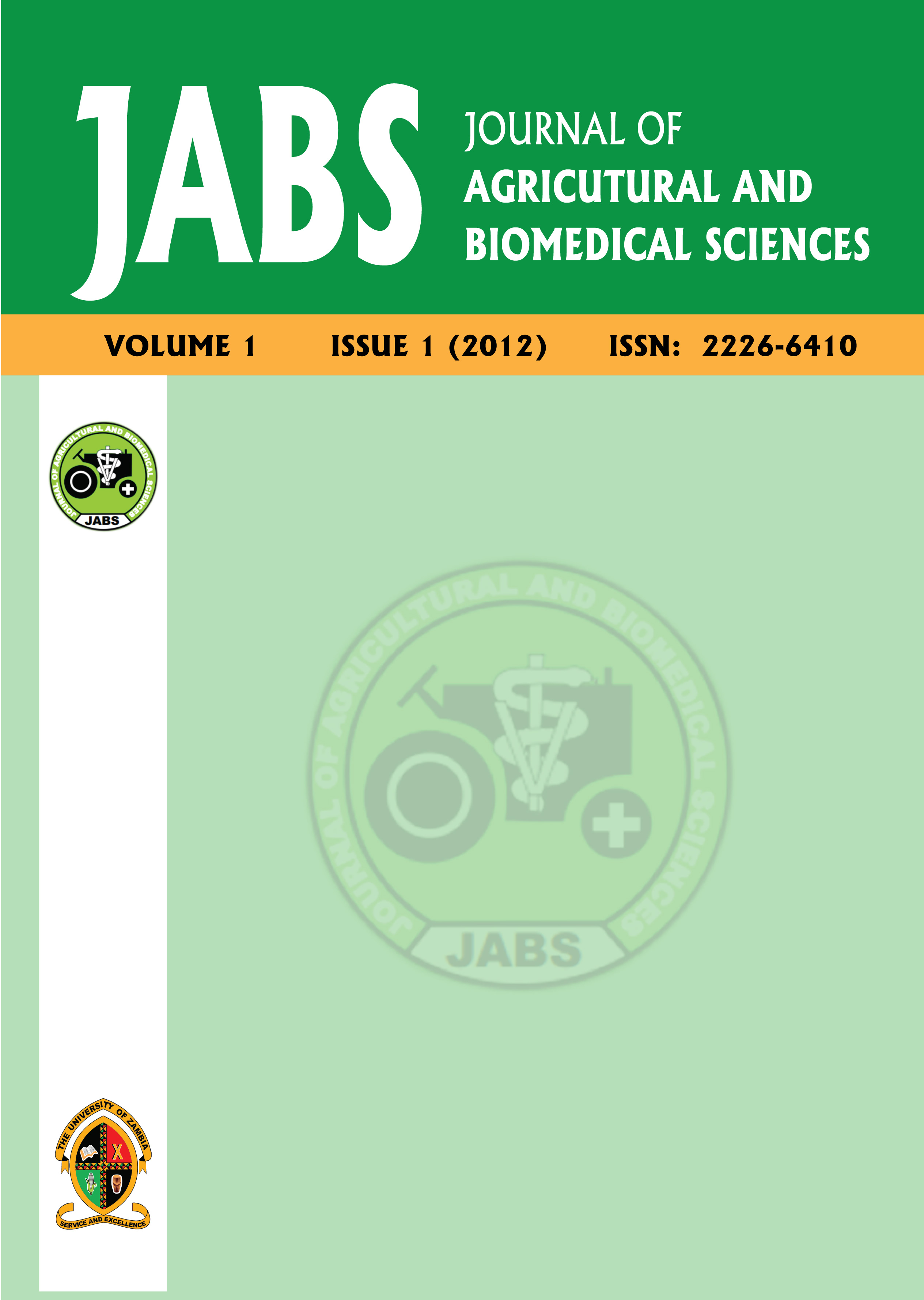Climate Variability Impact on Livelihood Strategies Among Agro-Pastoralists in Southern Province of Zambia
Keywords:
Extreme Weather Conditions, Adaption, Environmental Degradation
Abstract
The study was carried out in Choma District during the period of March to December 2010 to investigate the effect of climate variability and extreme weather conditions on livelihood coping practices among the agro-pastoralists. Climate data of the study area of a period of fifty years was used. Data on change in livelihood strategies were collected through the use of semi-structured questionnaires and observation. Sixty (60) households from 10 villages were selected for the study. Climate data revealed that there has been an increase of 1.0-degree Celcius in the average annual temperatures over the previous five decades. The rainfall data revealed that there has been an increase in variability in the amount of annual rainfall received. However, there was a general decline in average annual rainfall received over the same period. The major livelihood adaptable practices for the pastoralists in times of extreme weather conditions are livestock sales and engaging in non-agricultural activities. Harvest of products from the forest such as charcoal burning, sale of firewood, carpentry and carving, as well as the sale of thatching grass was the most important non-agricultural livelihood strategy (50.13%), followed by trading 30.51%. The least practiced activities were a collection of wild fruits and fishing 1.69%. This means that with increased climate variability there will be more pressure on the forest and forest products. This could lead to deforestation. Farmers have an understanding of climatic change and are engaged in various livelihood strategies to adapt to this change in the environment. The farmers should be encouraged to engage in sustainable adaptable livelihood strategies for survival. Harvesting of forest products during extreme weather conditions should be coupled with the replanting of these indigenous trees to avoid depletion of the forest and further environmental degradation.References
1. Abate T, Ebro A, Nigatu L. Pastoralists perceptions and rangeland evaluation for livestock production in South EasternEthiopia.LivestockResearchforRuralDevelopment. Volume 21, Article #101. Retrieved March 12,2011,fromhttp://www.lrrd.org/lrrd21/7/abat21101.htm
2. Ayana A, and Gufu O. Herder perceptions on impacts of range enclosures, crop farming, fire ban and bush encroachment on rangelands of Borana, southern Ethiopia. Human Ecology. 2008; 36: 201-215.
3. Ehrhart C. Pastoralists grapple with climate change. Integrated Regional Information Networks (IRIN) Nairobi 2009. http:// www. alertnet. org/ thenews/ newsdesk/IRIN/606b2950c116ecb361d79cad96e3d002.htm
4. PRIMEFACT. Tree management after drought. State of NewSouthWales,Australia,2007http://www.dpi.nsw.gov.au/__data/assets/pdf_file/0009/104013/tree-management-after-drought.pdfth
5. Intergovernmental Panel on climate change (IPCC) 4Assessment Report, World Meteorological Organisation, Geneva, Switzerland, 2007.
6. Zeidler J, and Chunga R. Drought Hazard and Land degradation management in the drylands of Southern Africa. Proceedings of the Climate and Degradation workshop Arusha, Tanzania 11-15 December, 2007.
7. McKeon GM, Stone GS, Syktus JI, Carter JO, Flood NR, Ahrens DG et al Climate change impacts on northern Australian rangeland livestock carrying capacity: a review of issues.Rangeland Journal. 2009; 31: 1-29.
8. Hume M, Doherty R, Ngara T, New M, and Lister D. African climate change: 1900-2100. Climate Research. 2001; 17: 145-168
9. Eckard R. Greenhouse Emissions from Australian Agriculture, Published by the Victorian Government Department of Primary Industries Primary Industries Research Victoria 1301Hazeldean RoadEllinbankVictoria 3821 Australia, 2007
2. Ayana A, and Gufu O. Herder perceptions on impacts of range enclosures, crop farming, fire ban and bush encroachment on rangelands of Borana, southern Ethiopia. Human Ecology. 2008; 36: 201-215.
3. Ehrhart C. Pastoralists grapple with climate change. Integrated Regional Information Networks (IRIN) Nairobi 2009. http:// www. alertnet. org/ thenews/ newsdesk/IRIN/606b2950c116ecb361d79cad96e3d002.htm
4. PRIMEFACT. Tree management after drought. State of NewSouthWales,Australia,2007http://www.dpi.nsw.gov.au/__data/assets/pdf_file/0009/104013/tree-management-after-drought.pdfth
5. Intergovernmental Panel on climate change (IPCC) 4Assessment Report, World Meteorological Organisation, Geneva, Switzerland, 2007.
6. Zeidler J, and Chunga R. Drought Hazard and Land degradation management in the drylands of Southern Africa. Proceedings of the Climate and Degradation workshop Arusha, Tanzania 11-15 December, 2007.
7. McKeon GM, Stone GS, Syktus JI, Carter JO, Flood NR, Ahrens DG et al Climate change impacts on northern Australian rangeland livestock carrying capacity: a review of issues.Rangeland Journal. 2009; 31: 1-29.
8. Hume M, Doherty R, Ngara T, New M, and Lister D. African climate change: 1900-2100. Climate Research. 2001; 17: 145-168
9. Eckard R. Greenhouse Emissions from Australian Agriculture, Published by the Victorian Government Department of Primary Industries Primary Industries Research Victoria 1301Hazeldean RoadEllinbankVictoria 3821 Australia, 2007
Published
2012-03-31
How to Cite
1.
Chibinga O, Musimba M, Nyangito M, Simbaya J, Moses D. Climate Variability Impact on Livelihood Strategies Among Agro-Pastoralists in Southern Province of Zambia. Journal of Agricultural and Biomedical Sciences [Internet]. 31Mar.2012 [cited 15Oct.2025];1(1):25-9. Available from: https://journals.unza.zm/index.php/JABS/article/view/333
Section
Agriculture Sciences
Copyright: ©️ JABS. Articles in this journal are distributed under the terms of the Creative Commons Attribution License Creative Commons Attribution License (CC BY), which permits unrestricted use, distribution, and reproduction in any medium, provided the original author and source are credited.

